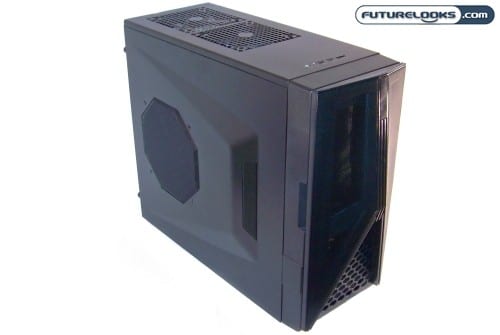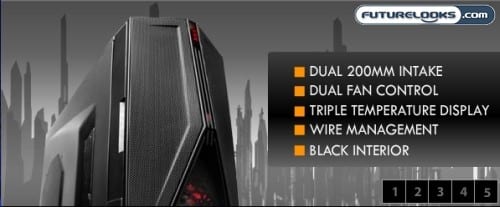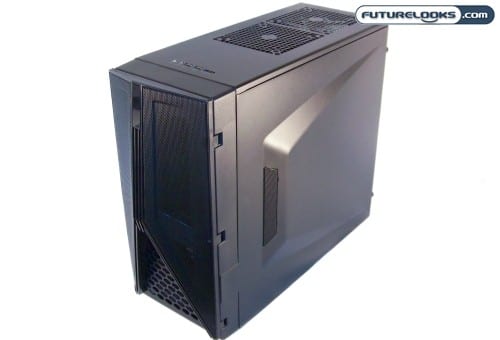
When the courier comes by to drop off new hardware, we always end up getting into a good conversation. The latest discussion was all about the NZXT Crafted Series Hades Computer Enclosure that we’re looking at today. It was interesting to hear the courier comment on things like the front bezel design and question the purpose of feature like the use of a temperature display. If he wasn’t on the job, he’d probably hang out and help review the case. I told him to check back to see what I came up with so without further adieu, we review the NZXT Hades Crafted Series Computer Enclosure.
Features and Specifications

For most consumers, case selection is based on a combination of these three important features: air flow, expansion, and unique case design. The Hades offers ample air flow via 2 x 120mm cooling fans, 1 x 140mm top cooling fan. It also has a massive 200mm side panel fan and there’s even room for another 120mm/1400mm fan up top. It’s optional but you can add your own but I’m sure users would still like to see the slot occupied by something.
Second, the case offers nine 5.25 inch bays for ROM type drives that can be changed to house up to five 5.25 inch devices and four 3.5 inch bays for hard drives. There is also a special 2.5 inch bay to accommodate up to two SSDs at the bottom of the drive bay. The case chassis has been extended to accommodate the ever growing size of high end video cards like the latest ATI HD5970 or old school nVidia GTX295.
An extra feature we’ve seen in other NZXT cases like the Guardian 921, is the addition of a small temperature display. There are three wired sensors inside that can be attached to things like the CPU cooler, chipset, and/or video card heat sinks. It’s your choice, so you pick.
Finally, the top of the case houses the ‘front panel’ expansion options like 2 USB, audio, and e-SATA ports. We’ve often wondered where the best place for these expansion ports should be and the top looks good.
The Hades’ Physique

Once again, we see a dramatic outward case design from NZXT. While you can never tell by pictures, the Hades is actually…light! I was expecting something a bit heavier since it’s made from standard dyed-in-the-chassis steel.
The case sports quite a bit of mesh. The mesh front door is partially hollow with the temp display dead center up top with a vented lower upside V-shaped half to allow the front internal red LED 120mm cooling fan to do its job.
Behind the door, the front bezel is also mostly mesh including the 5.25″ bay covers. Up and down the front, there is quite a bit of filter material for cutting back on internal dust monsters. The minor down side is that you’ll have to remove these for periodic cleaning. Hey, it’s either clean the entire inside of the case, or just some filters.
You can see the two bulges in both side panels. The right panel is offset and houses the 200mm cooling fan. The left side is offset so that any extra case or power supply wiring can be tucked in there to make the case look all tidy and organized.
The back of the case reveals that the entire chassis is jet black. Gamers love jet black painted or anodized steel. There’s a lot of ventilation machined in to the back of the case chassis. Plus, a couple water cooling ports are added in case you need to run some tubing.
Going Inside the NZXT Hades
After donning my heat and fire resistant suit, the side panels were removed to get a look inside Hades. There weren’t any smoke or flames, but there was a hot sexy, black chassis staring back.
The chassis is indeed extended and sports several worthy features that include tooless 5.25″ bays up top specified by the white quick release buttons. The lower area is vented for mounting power supplies and black rubber lined grommet holes facilitate better cable management. A really large CPU cut-out in the motherboard tray makes CPU cooler installations easier.
At the bottom center of the drive bay frame, there is an area for mounting solid state drives (SSDs). Since the market will eventually start offering larger and more affordable SSDs, users will find this handy. Otherwise, if a user wants to add a 128GB SSD for their OS boot drive, they’ve got a nice out of the way spot.
Taking a look at the left side (back of the motherboard tray), you can see that the tray sits inward just enough to get some wires in there between the panel and chassis. NZXT includes some zip ties so you can keep them from moving around. Personally, I like insulated wire ties. They’re reusable and not so permanent.
Test System Setup
Part of the case evaluation process is how easy things install, tuck in and clean up inside a good chassis. As a result, we’ve created the following list of components to install into this case. Even though the Hades is not strictly a gamer’s case, I decided to use components that create an “extreme overkill” situation which generates a worst case, thermal scenario.
The components include:
- Core i7 975 Bloomfield Processor
- GIGABYTE GA-X58A-UD5 Motherboard
- Kingston HyperX 6GB 2000MHz DDR3 Memory
- Zotac Geforce GTX295 (this thing gets hot!)
- Antec Quattro 1000 Watt Power Supply
- Two Seagate 500GB SATA2 Hard Drives
Next we’ll walk through some of the challenges during installation (if any) that you should know about.
Installation and Setup
While for the most part the setup process was uneventful, we ran in to a couple of specific obstacles that we thought were worth mentioning.
First, there are four slots specifically for hard drives that require using black drive mount adapters. For whatever reason, only three come inside the accessories box. Second, there aren’t any screws long enough to mount the hard drives because of the width of the black rubber grommets designed to liit hard drive vibrations. So, this puts a stop in the process until you hit the hardware store to find screws.
I picked up some 10mm black ones to match the mounts but more often than not we know NZXT to take care of their customers. But if you can’t wait, the 10mm screws work just fine.
On the other side of the coin, the 5.25″ trays are tooless and work pretty easily with most if not all optical drives. Simply slide them in, slide the black strip, and turn the white dial to lock it in place. Also, SSDs do fit nicely in to the small internal tray.
Also, the motherboard cut out is practically perfect in size. You will be able to get the largest CPU coolers and back plates known to man kind in there without issue. This is a welcomed feature and should be a standardized design across the market.
Measuring Temps Inside Hades
Testing is pretty simple. We took temperature readings inside the case while operating this gaming system at full load running things like Unigine 3D Heaven Demo and OCCT looping for at about half an hour. Then, we took noise measurements from the front, back, and sides of the case to round out our performance measurements.
Temperature Readings
Here’s what we got for temperatures and that’s not bad at all. It was kind of expected seeing that the case doesn’t come with a fan controller. So that means the fans are spinning pretty much full speed at all times. For those interested, adding a fifth cooling fan up top helped drop internal temps by only 2 two more degrees but it does help.
Noise Levels
As for noise, I was expecting a lot more noise. The noise level meter recorded a maximum of 26dB which was loudest up top and to the back. The side fan was relatively quieter mainly due to how little it actually has to spin to move large amounts of air.
Final Thoughts
It’s nice to see the NZXT Hades take a good step forward in internal case aesthetics by offering a solid black internal chassis paint j0b. It also goes a long way to compliment the outward case design. Unfortunately, you can’t go by NZXT’s website pictures which don’t do the Hades any favors or properly depict its actual characteristics. Aside from the issue of the missing/too short screws, which we’re sure NZXT will correct in future shipments, the enclosure was a pleasure to work with and the front red LED fan wasn’t obtrusive at all.
The Hades enclosure does a great job of balancing cooling and fan noise. It will easily take the looks of your computer to the next level no matter what its purpose might be. But of course, gaming is where it’s at.
The NZXT Hades is a nice light-weight case with an excellent design and all black paint job that can be found for $90 to $100 online. That makes it a very good choice for the gamer looking for something unique without breaking the bank. The Hades case is definitely hot and for this price, a really great value.
Pros
- Interesting bezel and panel design
- Black chassis inside and out is HOT!
- Ample cooling without the noise
- Fan and bezel filters
- Great cable management
- CPU cut out for easy cooler installs
- Lightweight for a steel chassis but still high quality
Cons
- The design may not suit everyone
- One empty fan slot seems a little incomplete
- Proper hard drive screws need to be included
- White cooling fans very visible from the outside
Overall Rating: 8.0 / 10.0
Love This Review? Hate This Review? Click Here to Comment!
NZXT Hades Crafted Series Midtower ATX Enclosure Photo Gallery
